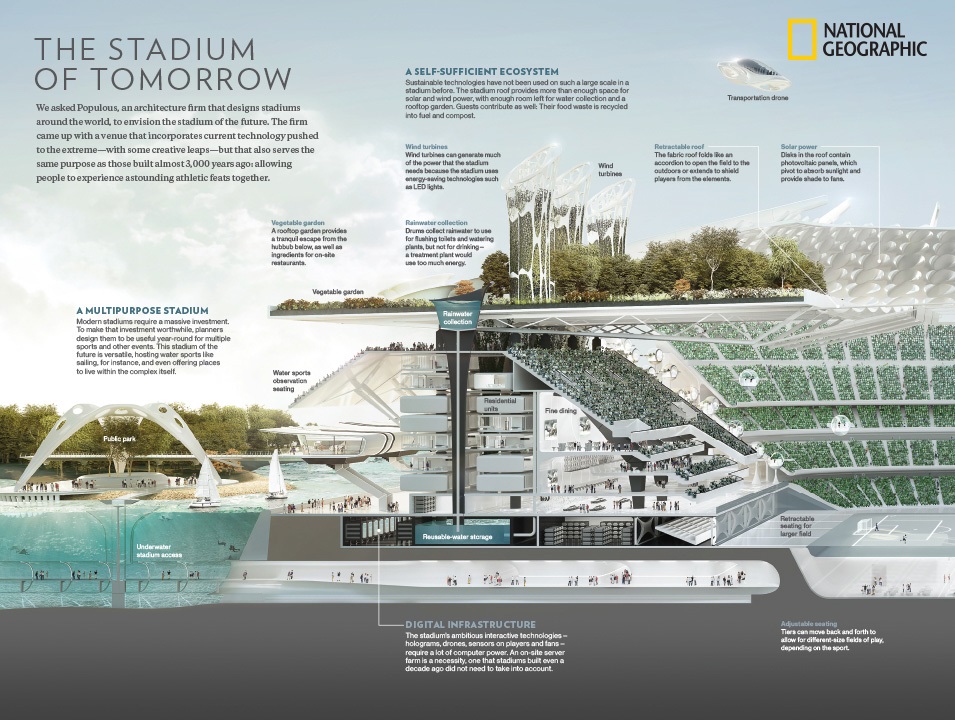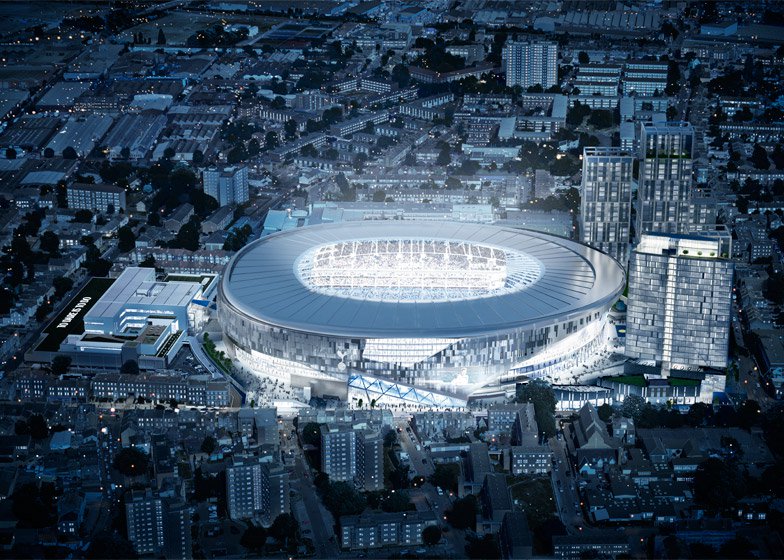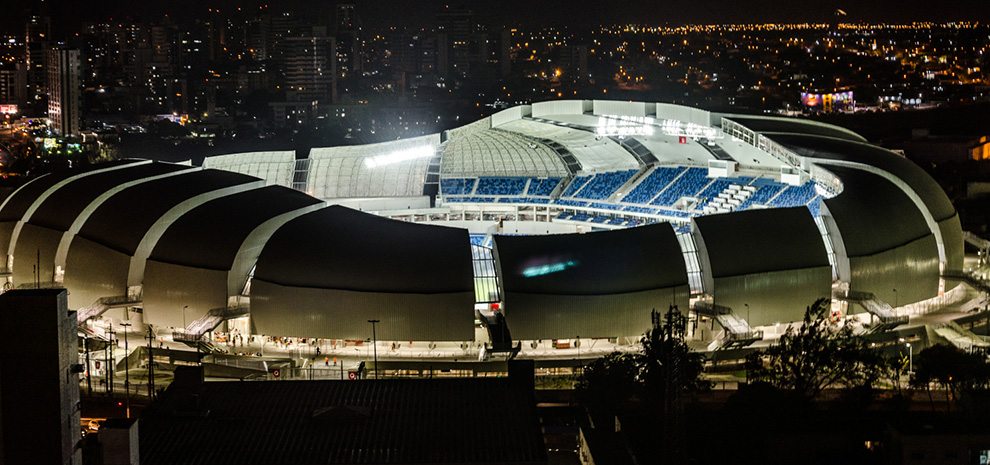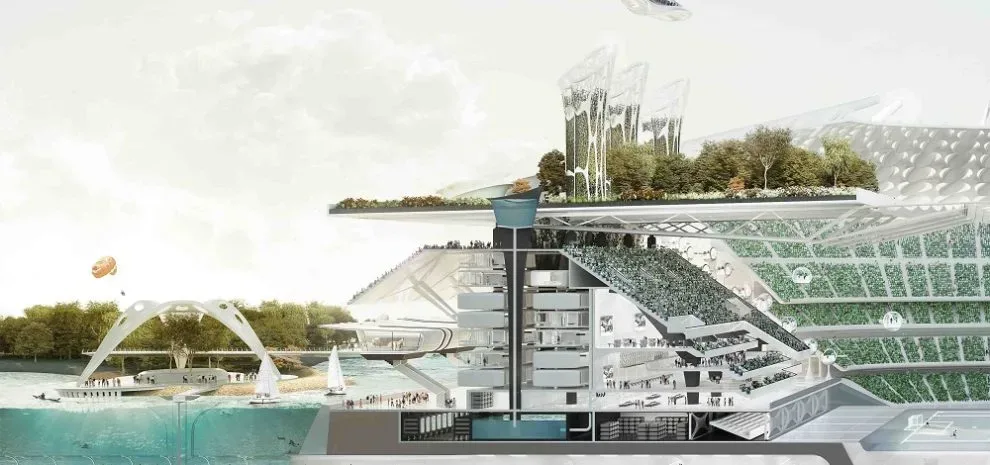Technology and sports, both a perfect match that need to keep working together for a successful development in the football industry. Those two elements are the reason for transforming the way we know a Football Stadium nowadays and design the future of the spectators experience.
This time, Populous, the global architecture firm and the designers of places like Yankee Stadium, the London Olympics, and the Super Bowl, have teamed up with National Geographic Magazine to imagine a vision of the future for football stadium design, exploring how technology will transform the spectator experience. Over the last 30 years, the firm has designed more than 2,000 projects worth $40 billion across emerging and established markets.
National Geographic magazine and Populous come up for July’s issue with ‘The Stadium of Tomorrow’. The global firm has conceived a self-sustaining, highly connected and versatile arena that is more of an eco-village of sport and recreation than a traditional football stadium. The vision capitalises on infrastructure required for a sports stadium, creating multi-use, multi-experiential ecosystem with a plethora of sports and recreation opportunities ranging from traditional field sports such as athletics, ice hockey and football stadiums to non-typical sports venues such as extreme sports, sailing, surfing and e-sports. The vision extends as far as the stadium of tomorrow being a place where people live, work and play.

Architects from Populous, inspired by the desire for versatility, consider a fundamental rethink of how the playing field looks and works according to what sport is being played. Employing an LED surface, the pitch changes textures and materials for different sports; from Astroturf for football to grass for soccer to wood for basketball.
The lines marking the area of play are projected onto the field, allowing the field to vary in size and shape and there is even scope to make the field transparent, opening up possibilities for an underground viewing area to enable fans to watch the action from a whole new angle.
“The viewing experience within a stadium environment has not fundamentally changed since Vespasian ordered the construction of the Colosseum almost 2,000 years ago. Technology and information technology is literally changing the playing field and providing an opportunity to create a new vision for both the experience of watching and playing sport but also for the role a stadium can play as a significant urban influencer.” said Christopher Lee, Populous MD EMEA.
At the Football Stadium, the use of LED technology and augmented reality to bridge the gap between the fan, the remote fan and the player experience making the The Stadium of Tomorrow highly interactive. In the future, the crowd may be able to share their emotions through LED clothing or even experience what the players are feeling. Fans in smart-kit might feel the heartbeats of their favorite player or light up in colors to reflect the mood of the game.
“Stadiums have a long and interesting history, and each architectural innovation has changed the way people come together for large sporting and cultural events. This experiment allows our readers to see how architects and designers engage with how people use these spaces. It also gives us context for how problems are solved and pulls back the curtain a bit on how stadiums are designed, allowing our readers to see the process behind innovations that they could encounter in the future.” said Jason Treat, senior graphics editor with National Geographic.

This Football Stadium also envisions adding the best bits of TV sports coverage to the live, first-hand experience. A large holograph will hover over the field with the score and player stats, while smaller versions are literally displayed on the rear of seats for individual and tailored experiences for all spectators.
Automated amenities including the drone-delivery of refreshments to your seat and the use of robots to serve food and drink and take rubbish away will deliver a unique experience to the visitors. Automation will also extend to electro-magnetic hospitality pods that will move along rails within the Football Stadium, allowing fans a view from anywhere they like.
The Stadium of Tomorrow will look towards creating a fully self-sufficient ecosystem in order to sustain the digital infrastructure. In terms of the roof, the stadium will provide sustainable technologies such as solar, tidal, wind power and kinetic energy harvesting electricity from the movement of the spectators on a large scale, with enough room left for water collection and a rooftop garden. The food waste would be recycled via biodigesters into fuel and compost.
Maria Knutsson-Hall, Associate Principal at Populous, said: “the Stadium of Tomorrow envisions a stadium ecosystem that creates a sustainable vision that incorporates social, economic and environmental sustainability. It will create an urban superblock that not only forms 7-day-a-week sports and recreation opportunities, but generates a highly connected infrastructure and transportation hub where people live, work and play.”

Wind turbines will be installed at the Football Stadium to generate the power that the venue needs to operate and LED lights to use less energy. Even the experience of getting to the stadium is transformed with those spectators that do not alight at a station within the stadium, via a high-speed train on magnetic rails, being delivered by drone directly to their seats. Other fans will have the option of traveling through an underwater tube for an aquarium-like experience.
The Populous concept also ensures fans that can’t be accommodated within the Football Stadium will still be connected with the action via adjacent viewing towers that allow ticket holders to watch the game while enjoying an elevated tailgate party.
The towers will in turn inform neighbouring city dwellers of the progress of the game by pulsating with colors that vary depending on the crowd’s reaction.
Special thanks to Populous for sharing this article with us.

